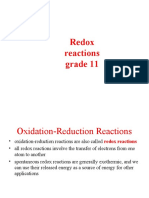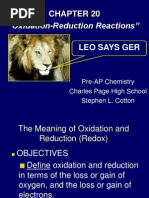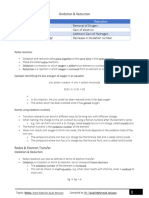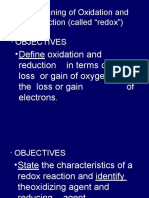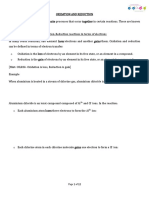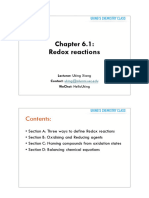Redox Apr 2024
Redox Apr 2024
Uploaded by
Jasmine GabaitsiweCopyright:
Available Formats
Redox Apr 2024
Redox Apr 2024
Uploaded by
Jasmine GabaitsiweCopyright
Available Formats
Share this document
Did you find this document useful?
Is this content inappropriate?
Copyright:
Available Formats
Redox Apr 2024
Redox Apr 2024
Uploaded by
Jasmine GabaitsiweCopyright:
Available Formats
Redox
Oxidation and Reduction
Core:
• Define oxidation and reduction in terms of oxygen loss/gain. (Oxidation
state limited to its use to name ions, e.g. iron(II), iron(III), copper(II),
manganate(VII).)
• Define redox in terms of electron transfer
Oxidation and reduction
• Oxidation and reduction take place together at the same time in the same reaction.
• These are called redox reactions.
• There are three definitions of oxidation. It is a reaction in which:
o oxygen is added to an element or a compound.
o an element, ion or compound loses electrons.
o the oxidation state of an element is increased.
• There are three definitions of reduction. It is a reaction in which:
o oxygen is removed from an element or a compound.
o an element, ion or compound gains electrons.
o the oxidation state of an element is decreased.
Oxidation state
• The oxidation state (also called oxidation number) is a number assigned to an atom or
ion in a compound which indicates the degree of oxidation (or reduction).
• The oxidation state helps you to keep track of the movement of electrons in a redox
process.
• It is written as a +/- sign followed by a number.
• E.g: O2- means that it is an atom of oxygen that has an oxidation state of -2. It is not
written as O2- as this refers to the ion and its charge.
Assigning the oxidation number
• Oxidation number refers to a single atom or ion
• The oxidation number of a compound is 0 and of an element (for example Br in Br2)
is also 0.
• The oxidation number of oxygen in a compound is always -2 (except in peroxide R-
O-O-R, where it is -1).
• For example in FeO, oxygen is -2 then Fe must have an oxidation number of +2 as the
overall oxidation number for the compound must be 0.
Ionic Equations
• Ionic equations are used to show only the particles that actually take part in a reaction.
• These equations show only the ions that change their status during a chemical process,
i.e: their bonding or physical state changes.
Source of notes: savemyexams.co.uk
• The other ions present are not involved and are called spectator ions.
Writing ionic equations
• For the neutralisation reaction between hydrochloric acid and sodium hydroxide:
HCl(aq) + NaOH(aq) → NaCl(aq) + H2O(l)
• If we write out all of the ions present in the equation and include the state symbols,
we get:
H+(aq) + Cl– (aq)+ Na+(aq) + OH–(aq) → Na+ (aq)+ Cl–(aq) + H2O(l)
• The spectator ions are thus Na+ and Cl–. Removing these from the previous equation
leaves the overall net ionic equation:
H+(aq) + OH–(aq) →H2O(l)
• This ionic equation is the same for all acid-base neutralisation
Example redox equation: oxygen loss/gain
Zinc oxide + carbon → zinc + carbon monoxide
ZnO + C → Zn + CO
• In this reaction the zinc oxide has been reduced since it has lost oxygen. The carbon
atom has been oxidised since it has gained oxygen.
Example redox equation: electron loss/gain and oxidation state
Zinc + copper sulphate → zinc sulphate + copper
Zn + CuSO4 → ZnSO4 + Cu
• Writing this as an ionic equation:
Zn(s) + Cu2+(aq) + SO42-(aq) →Zn2+(aq) + SO42-(aq) + Cu(s)
• By analysing the ionic equation, it becomes clear that zinc has become oxidised as its
oxidation state has increased and it has lost electrons:
Zn(s) →Zn2+(aq)
• Copper has been reduced as its oxidation state has decreased and it has gained
electrons:
Cu2+(aq) → Cu(s)
Source of notes: savemyexams.co.uk
Exam Tip
Use the mnemonic OIL-RIG to remember oxidation and reduction in terms of the movement
of electrons:
Oxidation Is Loss – Reduction Is Gain
Redox Reactions
Supplement:
• Identify redox reactions by changes in oxidation state and by the colour
changes involved when using acidified potassium manganate(VII), and
potassium iodide. (Recall of equations involving KMnO4 is not required.)
• Define oxidising agent as a substance which oxidises another substance
during a redox reaction. Define reducing agent as a substance which
reduces another substance during a redox reaction
• Identify oxidising agents and reducing agents from simple equations
Oxidising agent
• A substance that oxidises another substance, in so doing becoming itself reduced.
• Common examples include hydrogen peroxide, fluorine and chlorine.
Reducing agent
• A substance that reduces another substance, in so doing becoming itself oxidised.
• Common examples include carbon and hydrogen.
• The process of reduction is very important in the chemical industry as a means of
extracting metals from their ores.
Example
CuO + H2 →Cu + H2O
• In the above reaction, hydrogen is reducing the CuO and is itself oxidised, so the
reducing agent is therefore hydrogen.
• The CuO is reduced to Cu and has oxidised the hydrogen, so the oxidising agent is
therefore copper oxide.
Source of notes: savemyexams.co.uk
Identifying redox reactions
• Redox reactions can be identified by the changes in the oxidation states when a
reactant goes to a product.
Example
Chlorine + potassium iodide → potassium chloride + iodine
Cl2 + 2KI → 2KCl + I2
Chlorine has become reduced as its oxidation state has decreased from 0 to -1 on changing
from the chlorine molecule to chloride ions:
Cl2(g) → 2Cl–(aq)
• Iodine has been oxidised as its oxidation state has increased from -1 to 0 on
changing from iodide ions to the iodine molecule:
2I+(aq) → I2(s)
Identifying redox reactions by colour changes
• The tests for redox reactions involve the observation of a colour change in the
solution being analysed.
• Two common examples are acidified potassium manganate(VII), and potassium
iodide.
• Potassium manganate (VII), KMnO4, is an oxidising agent which is often used to test
for the presence of reducing agents.
• When acidified potassium manganate (VII) is added to a reducing agent its colour
changes from pink-purple to colourless.
• Potassium iodide, KI, is a reducing agent which is often used to test for the presence
of oxidising agents.
• When added to an acidified solution of an oxidising agent such as aqueous chlorine or
hydrogen peroxide, the solution turns a brown colour due to the formation of iodine.
Source of notes: savemyexams.co.uk
You might also like
- PDF Chemistry For Today General Organic and Biochemistry 9th Edition Spencer L. Seager Download100% (5)PDF Chemistry For Today General Organic and Biochemistry 9th Edition Spencer L. Seager Download49 pages
- Science Test-1 Module2 Unit2.1 and - 2.2No ratings yetScience Test-1 Module2 Unit2.1 and - 2.211 pages
- Class XI Chemistry Unit-8 Redox Reactions: Topic67% (3)Class XI Chemistry Unit-8 Redox Reactions: Topic60 pages
- Class 11 - Chapter 08 - Redox Reaction NotesNo ratings yetClass 11 - Chapter 08 - Redox Reaction Notes14 pages
- Explanation Text: By: Dwiyanti Octaviani Farrah Nabila F Malik Farhan Nazhara Ardhan Roikhan Azhari Syifa FauziahNo ratings yetExplanation Text: By: Dwiyanti Octaviani Farrah Nabila F Malik Farhan Nazhara Ardhan Roikhan Azhari Syifa Fauziah28 pages
- 11.4A Redox Reaction and ElectrochemistryNo ratings yet11.4A Redox Reaction and Electrochemistry98 pages
- Inorganic Reaction Mechanism: Prepared By: Ms - Sumina IbrahimNo ratings yetInorganic Reaction Mechanism: Prepared By: Ms - Sumina Ibrahim17 pages
- Chemistry Handout 12 REF #: 012: Reduction and OxidationNo ratings yetChemistry Handout 12 REF #: 012: Reduction and Oxidation5 pages
- Oxidation Reductionreactions 100429191952 Phpapp01No ratings yetOxidation Reductionreactions 100429191952 Phpapp0124 pages
- 2425 G10S UAE Chemistry Chapter 4 notesNo ratings yet2425 G10S UAE Chemistry Chapter 4 notes25 pages
- Hsslive Xi Chem Notes Anil CH 8. REDOX REACTIONSNo ratings yetHsslive Xi Chem Notes Anil CH 8. REDOX REACTIONS6 pages
- Chapter 20 Oxidation-Reduction ReactionsNo ratings yetChapter 20 Oxidation-Reduction Reactions36 pages
- Orca Share Media1679932480278 7046147521763878353No ratings yetOrca Share Media1679932480278 704614752176387835313 pages
- Chapter 7 Electrochemistry - Redox ReactionNo ratings yetChapter 7 Electrochemistry - Redox Reaction37 pages
- 7_1_Chemical Reaction Pt2_Acid, Base, SaltNo ratings yet7_1_Chemical Reaction Pt2_Acid, Base, Salt11 pages
- D0598782 PASCO IonicCovalentCompounds T MigNo ratings yetD0598782 PASCO IonicCovalentCompounds T Mig8 pages
- PSPM 2000: Extra Exercise 4.4 Intermolecular Forces September 8, 2011No ratings yetPSPM 2000: Extra Exercise 4.4 Intermolecular Forces September 8, 20113 pages
- Detailed Analysis of Nsejs 2017 by ResonanceNo ratings yetDetailed Analysis of Nsejs 2017 by Resonance12 pages
- Ceramic Fabrication Technology: Roy W. RiceNo ratings yetCeramic Fabrication Technology: Roy W. Rice362 pages
- Empirical and Molecular Formulas WorksheetsNo ratings yetEmpirical and Molecular Formulas Worksheets1 page
- 2013 NJC H1 Chemistry Paper 1 Questions and AnswersNo ratings yet2013 NJC H1 Chemistry Paper 1 Questions and Answers14 pages
- CBSE Class 10 Science Question Paper SA1 2010No ratings yetCBSE Class 10 Science Question Paper SA1 201038 pages
- Simulation: Ionic and Covalent Bonding Background: NameNo ratings yetSimulation: Ionic and Covalent Bonding Background: Name6 pages
- PDF Chemistry For Today General Organic and Biochemistry 9th Edition Spencer L. Seager DownloadPDF Chemistry For Today General Organic and Biochemistry 9th Edition Spencer L. Seager Download
- Explanation Text: By: Dwiyanti Octaviani Farrah Nabila F Malik Farhan Nazhara Ardhan Roikhan Azhari Syifa FauziahExplanation Text: By: Dwiyanti Octaviani Farrah Nabila F Malik Farhan Nazhara Ardhan Roikhan Azhari Syifa Fauziah
- Inorganic Reaction Mechanism: Prepared By: Ms - Sumina IbrahimInorganic Reaction Mechanism: Prepared By: Ms - Sumina Ibrahim
- Chemistry Handout 12 REF #: 012: Reduction and OxidationChemistry Handout 12 REF #: 012: Reduction and Oxidation
- Oxidation Reductionreactions 100429191952 Phpapp01Oxidation Reductionreactions 100429191952 Phpapp01
- Practice Makes Perfect in Chemistry: Oxidation-ReductionFrom EverandPractice Makes Perfect in Chemistry: Oxidation-Reduction
- PSPM 2000: Extra Exercise 4.4 Intermolecular Forces September 8, 2011PSPM 2000: Extra Exercise 4.4 Intermolecular Forces September 8, 2011
- 2013 NJC H1 Chemistry Paper 1 Questions and Answers2013 NJC H1 Chemistry Paper 1 Questions and Answers
- Simulation: Ionic and Covalent Bonding Background: NameSimulation: Ionic and Covalent Bonding Background: Name










